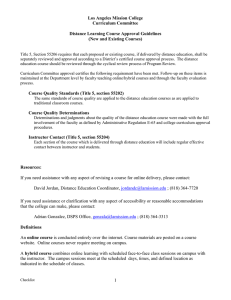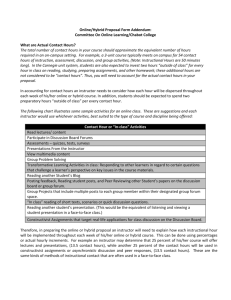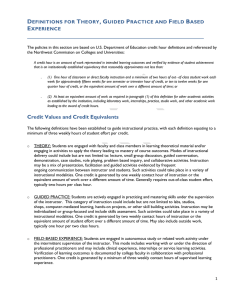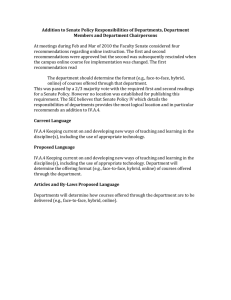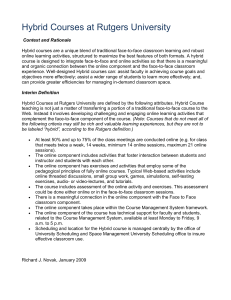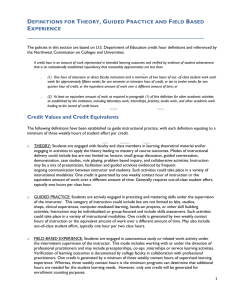Distance Education Format this course: Hybrid
advertisement
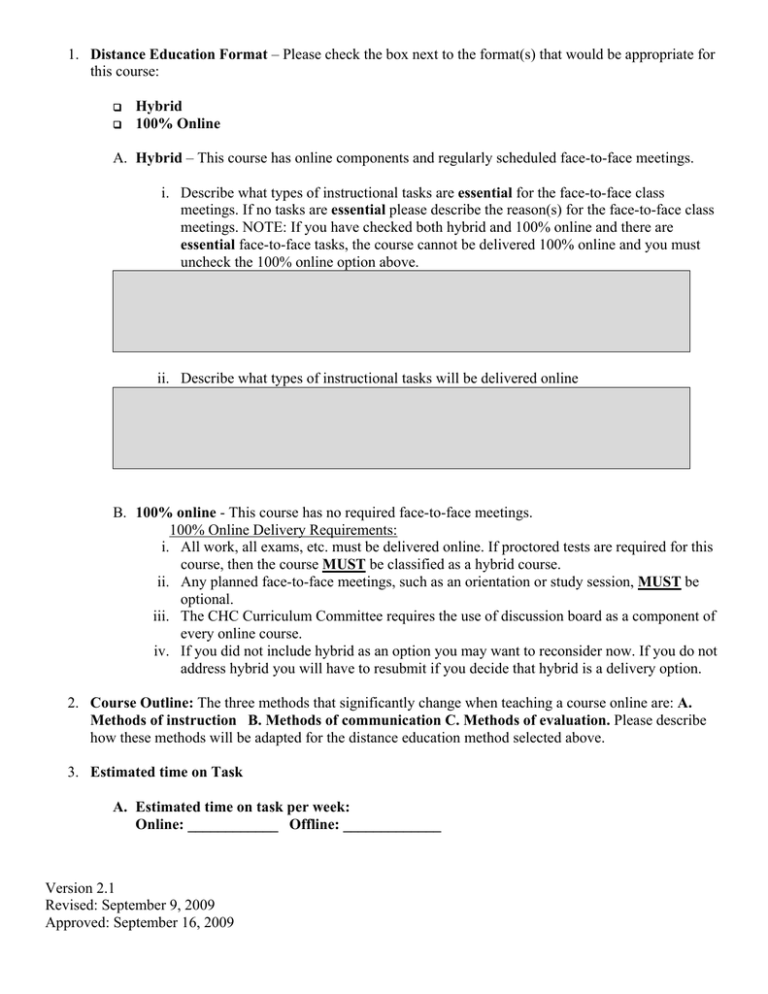
1. Distance Education Format – Please check the box next to the format(s) that would be appropriate for this course: Hybrid 100% Online A. Hybrid – This course has online components and regularly scheduled face-to-face meetings. i. Describe what types of instructional tasks are essential for the face-to-face class meetings. If no tasks are essential please describe the reason(s) for the face-to-face class meetings. NOTE: If you have checked both hybrid and 100% online and there are essential face-to-face tasks, the course cannot be delivered 100% online and you must uncheck the 100% online option above. ii. Describe what types of instructional tasks will be delivered online B. 100% online - This course has no required face-to-face meetings. 100% Online Delivery Requirements: i. All work, all exams, etc. must be delivered online. If proctored tests are required for this course, then the course MUST be classified as a hybrid course. ii. Any planned face-to-face meetings, such as an orientation or study session, MUST be optional. iii. The CHC Curriculum Committee requires the use of discussion board as a component of every online course. iv. If you did not include hybrid as an option you may want to reconsider now. If you do not address hybrid you will have to resubmit if you decide that hybrid is a delivery option. 2. Course Outline: The three methods that significantly change when teaching a course online are: A. Methods of instruction B. Methods of communication C. Methods of evaluation. Please describe how these methods will be adapted for the distance education method selected above. 3. Estimated time on Task A. Estimated time on task per week: Online: ____________ Offline: _____________ Version 2.1 Revised: September 9, 2009 Approved: September 16, 2009 B. Methods of Instruction: Copy the Methods of Instruction from the course outline into the space below. Specify any adaptations in instructional methodology resulting from offering this course either as a hybrid or 100% online as opposed to the face-to-face mode assumed by the current course outline. i. Examples of Online Methods of Instruction: Course management systems (CMS) Discussion boards; instructor developed web lectures; converted Power Point presentations; digital video clips; graphics (digital charts, diagrams, photos, images, annotated screen shots); digital animations; web quests; online reference resources; chat; email; publisher-prepared online materials; course cartridge materials; CD/DVD support materials; instructor web site; online library resources; text book supplements. Methods of Instruction Example: Lecture and Discussion will be used to analyze and synthesize major trends in twentieth century history. DE Adaptation Example: Lecture will be accomplished using instructor prepared web based lectures and links to appropriate reference sites and historical web sites. Discussions will take place using the course management system discussion board in both group and whole class settings. C. Methods of Communication/Interactions: In traditional face-to-face courses interactions such as teacher to student and student to student occur throughout the face-to-face class time or during scheduled office hours. How will this course meet the communication/interactions necessary for effective learning and instruction? i. Examples of DE Methods of Communication: Please select all that apply E-mail Web Casts Discussion Boards (Asynchronous Dialogue) Chat (Synchronous Dialogue) On Campus Meeting Announcements Office Hours Other (please describe in the box below) Methods of Communication DE Adaptation for Effectiveness Example:(complete for each method selected above) E-mail Example: Students will be contacted via email on a weekly basis to be kept up to date with course progress and requirements. Version 2.1 Revised: September 9, 2009 Approved: September 16, 2009 D. Methods of Evaluation: Copy your methods of evaluation from the course outline into the space below and describe how the evaluation methods in the course outline will be adapted for use in the online environment. i. Examples of Online Methods of Evaluation: Essays and research papers submitted via email attachments; Open-book essay and short answer exam questions submitted via email; timed quizzes and tests using the CMS; projects submitted via attachments in the CMS discussion forum; online discussion participation (pairs, groups, whole class); proctored exams. Methods of Evaluation Example: Research projects in specified topics will be completed. Exams evaluating the students’ comprehension of the effects of technology on politics will be given. Online Adaptation Example: Students will use the college online library and specified web site references to complete a research project that will be submitted to the instructor via email attachment. Proctored exams that can happen either at the college learning center or at the location agreed upon by the student and the instructor will take place twice in a semester. 4. Sample Assignment: Please provide an example of an assignment that students will complete online. Show the assignment as it would be given to the student. The sample assignment needs to include instructions for how students are to submit the assignment online. 5. Accessibility: Accommodations regarding disabled student accessibility to online content must be made as prescribed in the Distance Education Guidelines regarding Section 508, as published by the California Community College Chancellor’s office. For example: The following are general principles that should be followed in ensuring that distance education courses are accessible to students with disabilities. 1. All DE resources must be designed to afford students with disabilities maximum opportunity Version 2.1 Revised: September 9, 2009 Approved: September 16, 2009 to access distance education resources “anytime, anywhere” without the need for outside assistance (i.e. sign language interpreters, aides, etc.). 2. Distance education resources must generally be designed to provide “built-in” accommodation (i.e. closed captioning, descriptive narration) and/or interface design/content layout, which is accessible to “industry standard” assistive computer technology in common use by persons with disabilities. 3. Whenever possible, information should be provided in the alternative format preferred by the student. 4. Adoption of access solutions which include assigning assistants (i.e. sign language interpreters, readers) to work with an individual student to provide access to distance education resources should only be considered as a last resort when all efforts to enhance the native accessibility of the course material have failed. 5. Access to DE courses, resources and materials include the audio, video and text components of courses. Access to resources and materials include the audio, video, multimedia and text components of Web sites, electronic chat rooms, e-mail, instructional software, CD-ROM, DVD, laser disc, video tape, audio tape, electronic text and print materials. Where access to Web sites not controlled by the college is required or realistically necessary to completion of a course, the college must take steps to ensure that such sites are accessible or provide the same material by other accessible means. 6. Distance education courses, resources and materials must be designed and delivered in such a way that the level of communication and course taking experience is the same for students with or without disabilities. Please describe in the box below how your course will be modified to meet the Section 508 requirements for online instruction: Version 2.1 Revised: September 9, 2009 Approved: September 16, 2009
